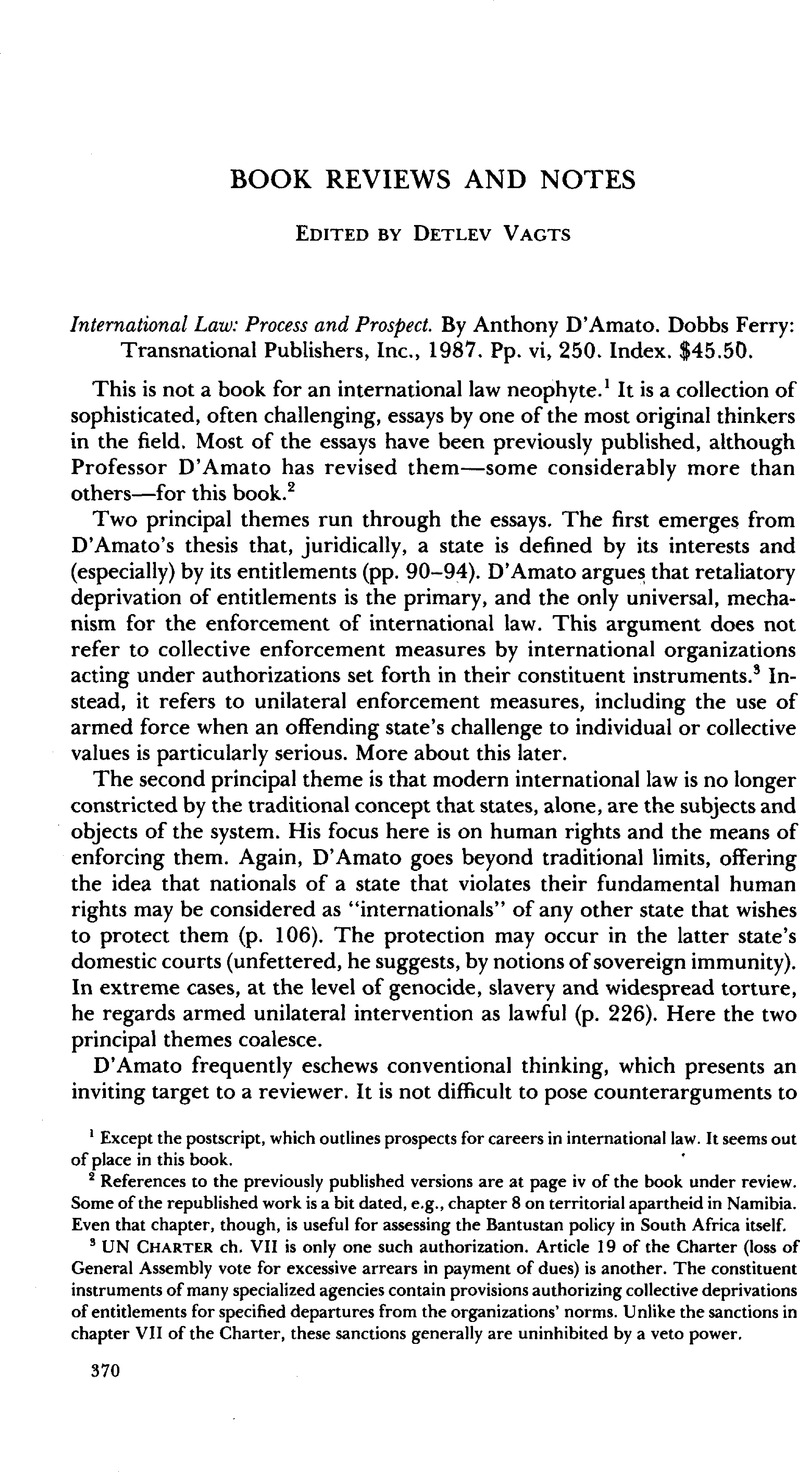No CrossRef data available.
Published online by Cambridge University Press: 27 February 2017

1 Except the postscript, which outlines prospects for careers in international law. It seems out of place in this book.
2 References to the previously published versions are at page iv of the book under review. Some of the republished work is a bit dated, e.g., chapter 8 on territorial apartheid in Namibia. Even that chapter, though, is useful for assessing the Bantustan policy in South Africa itself.
3 UN Charter ch. VII is only one such authorization. Article 19 of the Charter (loss of General Assembly vote for excessive arrears in payment of dues) is another. The constituent instruments of many specialized agencies contain provisions authorizing collective deprivations of entitlements for specified departures from the organizations’ norms. Unlike the sanctions in chapter VII of the Charter, these sanctions generally are uninhibited by a veto power.
4 Cf. Stein, , Collective Enforcement of International Obligations, 47 Zeitschrift für ausländisches öffentliches Recht und Völkerrecht 56, 65–66 (1987)Google Scholar. See also Zemanek, , The Unilateral Enforcement of International Obligations, id. at 32, 38–39 Google Scholar (setting forth the widely shared view that the use of armed force in reprisal is unlawful).
5 He acknowledges that international law has not yet gone this far (pp. 83–84).
6 See, e.g., American Convention on Human Rights, Nov. 22, 1969, reprinted in Organization of American States, Handbook of Existing Rules Pertaining to Human Rights in the Inter-American System, OEA/Ser.L/V/II.60, Doc. 28, at 29 (1983); [European] Convention for the Protection of Human Rights and Fundamental Freedoms, Nov. 4, 1950, 213 UNTS 221; Convention on the Prevention and Punishment of the Crime of Genocide, Dec. 9, 1948, 78 UNTS 277; International Labour Organisation Const, arts. 24–26, Apr. 20, 1948, 15 UNTS 35.
7 Sovereign immunity is not a problem if the defendant is a functionary of the foreign state, as in Filartiga v. Pena-Irala, 630 F.2d 876 (2d Cir. 1980), but enforcement of a judgment in such a case is likely to be a significant problem.
8 The decision of the Second Circuit in Amerada Hess Shipping Corp. v. Argentine Republic, 830 F.2d 421 (2d Cir. 1987), 26 ILM 1375 (1987), petition for cert, filed, 56 U.S.L.W. 3592 (U.S. Mar. 1, 1988) (No. 87-1372), offers D’Amato some comfort. Sovereign immunity was denied to the Argentine Government in a civil action arising out of its bombing of a neutral merchant vessel on the high seas during the Falkland Islands hostilities. The court relied on the Alien Tort Statute, 28 U.S.C. § 1350, brushing aside the Foreign Sovereign Immunities Act, 28 U.S.C. §§1330, 1602–1611, as irrelevant to noncommercial claims of violation of international law. This is not the place to analyze Amerada Hess. Suffice it to say that the majority’s reasoning in that case is faulty. Elsewhere in this issue I have tried to explain why. See p. 323 supra.
9 20 U.S. (7 Wheat.) 283 (1822).
10 In the leading sovereign immunity case of the same era, The Schooner Exchange v. M’Faddon, 11 U.S. (7 Cranch) 116 (1812), the claim was directly against a naval vessel flying the French flag. The libelants asserted that the vessel had been forcibly taken from them at sea by order of Napoleon—an assertion of a taking in violation of international law. D’Amato says (p. 202) that nothing in the case showed a French violation of international law, but the libelants were not allowed to make that showing because the vessel was in the possession of the foreign sovereign and therefore had immunity.
11 726 F.2d 774, 798–823 (D.C. Cir. 1984), cert, denied, 470 U.S. 1003 (1985).
12 On “self-executing custom,” see Henkin, , International Law as Law in the United States, 82 Mich. L. Rev. 1555 (1984)CrossRefGoogle Scholar; Kirgis, , Federal Statutes, Executive Orders and “Self-Executing Custom,” 81 AJIL 371 (1987)CrossRefGoogle Scholar.
13 D’Amato, A., The Concept of Custom in International Law 103–66 (1971)Google Scholar.
14 See Akehurst, , Custom as a Source of International Law, 47 Brit. Y.B. Int’l L. 1 (1974–75)Google Scholar.
15 The International Court has recognized the concept of “instant custom” (though not in these words), stemming from some multilateral treaties. North Sea Continental Shelf Cases (FRG/Den.; FRG/Neth.), 1969 ICJ Rep. 3, 42, para. 73 (Judgment of Feb. 20). See also the cases treating the exclusive economic zone, as articulated in the UN Convention on the Law of the Sea, as custom: Case Concerning the Continental Shelf (Tunisia/Libyan Arabjamahiriya), 1982 ICJ Rep. 18, 74 (Judgment of Feb. 24); Delimitation of the Maritime Boundary in the Gulf of Maine Area (Can. v. U.S.), 1984 ICJ Rep. 246,294 (Judgment of Oct. 12); Military and Paramilitary Activities in and against Nicaragua (Nicar. v. U.S.), Merits, 1986 ICJ Rep. 14, 111 (Judgment of June 27).
16 See A. D’Amato, supra note 13, at 104, 117–18, 121, 160, 266, 272. But see id. at 162–64, where he seems to go further and to suggest that generalizable provisions in treaties necessarily establish instant custom.